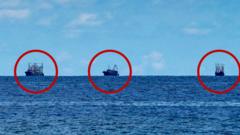
Pagasa Island: A Bastion of Sovereignty Amidst Maritime Tensions
A Tiny Outpost, A Monumental Stand
Pagasa Island, also known as Thitu Island, a small landmass in the contested Spratly Islands, serves as the largest Philippine-held territory in the South China Sea. While its airstrip is just barely long enough to accommodate military transport planes, Pagasa's strategic importance far outweighs its size. In recent years, it has become a focal point of escalating tensions in the region, primarily due to the persistent presence of a substantial number of Chinese vessels in its surrounding waters.
The Physical Reality: Infrastructure and Limitations
The island's infrastructure is modest but crucial for maintaining a Philippine presence. The aforementioned airstrip allows for resupply missions and personnel rotations. Additionally, Pagasa boasts a small community of Filipino civilians, a school, a health center, and essential communication facilities. However, the island remains vulnerable due to its limited size and the challenges posed by its remote location. Freshwater resources are scarce, and reliance on external supplies is constant.
The Maritime Standoff: A Visible Assertion of Claim
The presence of a significant number of Chinese Coast Guard and maritime militia vessels near Pagasa Island has become a regular occurrence, causing considerable concern within the Philippines and among its allies. These vessels often engage in what are perceived as provocative actions, including shadowing Philippine vessels, radio challenges, and, at times, aggressive maneuvers. The Philippines maintains that these actions violate international law, particularly the United Nations Convention on the Law of the Sea (UNCLOS), and infringe upon its sovereign rights within its Exclusive Economic Zone (EEZ).
Philippine Response and Diplomatic Efforts
The Philippine government has consistently protested the Chinese maritime presence and activities around Pagasa Island through diplomatic channels. These protests are lodged with the Chinese embassy in Manila and often raised in international forums. Beyond diplomacy, the Philippines has also sought to bolster its presence on and around the island through increased maritime patrols and infrastructure improvements, albeit within the constraints of its resources. There is an ongoing effort to upgrade the island's facilities to better support the resident community and the military personnel stationed there.
International Implications and Regional Security
The situation around Pagasa Island is not merely a bilateral issue between the Philippines and China; it has significant implications for regional security and the broader international order. The South China Sea is a vital waterway for global trade, and any actions that threaten freedom of navigation or undermine stability in the region are a cause for concern. Several countries, including the United States, have expressed their commitment to maintaining freedom of navigation in the South China Sea and have conducted naval operations in the area to demonstrate this commitment.
Perspectives on the Dispute
The dispute over the South China Sea is complex, involving competing territorial claims and historical narratives. China asserts its claim to much of the South China Sea based on historical grounds, a claim that is rejected by the Philippines and other claimant states. The Philippines, on the other hand, bases its claim on UNCLOS and the ruling of the Permanent Court of Arbitration in The Hague, which invalidated China's expansive claims in 2016. This ruling, however, has been rejected by China.
Looking Ahead: Potential Scenarios and Challenges
The future of Pagasa Island and the surrounding waters remains uncertain. Several potential scenarios could unfold, ranging from continued tensions and low-level confrontations to a negotiated resolution of the dispute. However, finding a mutually acceptable solution will require a commitment to dialogue, respect for international law, and a willingness to compromise on the part of all parties involved. The challenges are significant, but the stakes are too high to allow the situation to escalate further. The preservation of peace and stability in the South China Sea is essential for the prosperity of the region and the well-being of the global community.
Key Aspects of the Situation:
- Geographic location and strategic importance of Pagasa Island
- Chinese maritime presence and perceived provocative actions
- Philippine diplomatic protests and efforts to bolster its presence
- International implications and regional security concerns
- Competing territorial claims and historical narratives
- Potential future scenarios and challenges
Timeline of Key Events:
- 2012: Scarborough Shoal standoff between the Philippines and China
- 2016: Permanent Court of Arbitration ruling on the South China Sea
- Ongoing: Increased Chinese maritime presence around Pagasa Island
- Present: Continued diplomatic efforts and regional security concerns
